High Impact Tutoring Built By Math Experts
Personalized standards-aligned one-on-one math tutoring for schools and districts
In order to access this I need to be confident with:
Circle math Circumference of a circle Solving equations Law of sines Law of cosines Rounding Square rootArea of a sector
Here you will learn how to calculate the area of a sector including how to identify a sector of a circle, form and use the formula for the area of a sector of a circle, and calculate the area of a sector in various scenarios.
Students will first learn about the area of a sector as part of geometry in high school.
What is the area of a sector?
The area of a sector is the space inside the section of the circle created by two radii and an arc. It is a fraction of the area of the entire circle.

Major sector: a major sector has a central angle which is more than 180^{\circ}.
Minor sector: a minor sector has a central angle which is less than 180^{\circ}.
![[FREE] Common Core Practice Tests (Grades 3 to 6)](https://thirdspacelearning.com/wp-content/uploads/2023/10/common-core-practice-tests.png)
[FREE] Common Core Practice Tests (Grades 3 to 6)
![[FREE] Common Core Practice Tests (Grades 3 to 6)](https://thirdspacelearning.com/wp-content/uploads/2023/10/common-core-practice-tests.png)
Prepare for math tests in your state with these Grade 3 to Grade 6 practice assessments for Common Core and state equivalents. 40 multiple choice questions and detailed answers to support test prep, created by US math experts covering a range of topics!
DOWNLOAD FREE![[FREE] Common Core Practice Tests (Grades 3 to 6)](https://thirdspacelearning.com/wp-content/uploads/2023/10/common-core-practice-tests.png)
[FREE] Common Core Practice Tests (Grades 3 to 6)
![[FREE] Common Core Practice Tests (Grades 3 to 6)](https://thirdspacelearning.com/wp-content/uploads/2023/10/common-core-practice-tests.png)
Prepare for math tests in your state with these Grade 3 to Grade 6 practice assessments for Common Core and state equivalents. 40 multiple choice questions and detailed answers to support test prep, created by US math experts covering a range of topics!
DOWNLOAD FREEHow to find the area of a sector
In order to find the area of a sector, you need to be able to find the area of a circle.
This is because the area of a sector is part of the total area of the circle.
‘How much’ of the circle is decided by the angle created by the two radii.

The sum of the angle around a point is equal to 360^{\circ}, therefore the area of a sector is the fraction of the full circle’s area.
The angle is out of 360^{\circ} or \cfrac{\theta}{360}, where \theta (theta) represents the angle, so you can multiply this by the area of the circle to calculate the area of a sector.
To calculate the area of a sector, use the following formula:
\text{Area of a sector}=\cfrac{\theta}{360}\times\pi{r^2}
\theta – angle of the sector
r – radius of the circle
What is the area of a sector?
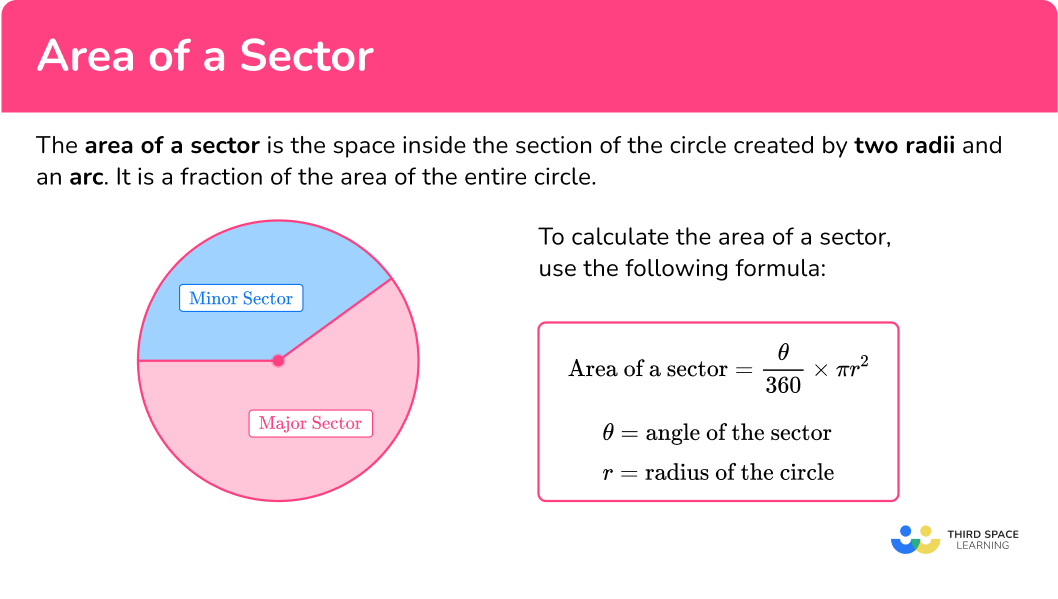
Common Core State Standards
How does this relate to high school math?
- High School – Geometry – Circles (HS.G.C.B.5)
Derive using similarity the fact that the length of the arc intercepted by an angle is proportional to the radius, and define the radian measure of the angle as the constant of proportionality; derive the formula for the area of a sector.
How to find the area of a sector
To find the area of a sector:
- Determine the length of the radius \textbf{r}.
- Find the size of the angle creating the sector \bf{\theta}.
- Substitute known values into the formula for the area of a sector and solve.
Area of a sector examples
Example 1: calculate the area of a sector (quadrant)
Calculate the area of the segment shown below.
Give your answer to the nearest thousandth.

- Determine the length of the radius \textbf{r}.
Radius: r=6\mathrm{~cm}
2Find the size of the angle creating the sector \bf{\theta}.
Angle: \theta=90^{\circ} (shown by the symbol of the right angle).
3Substitute known values into the formula for the area of a sector and solve.
\begin{aligned}A&=\cfrac{\theta}{360}\times\pi{r^2} \\\\ &=\cfrac{90}{360}\times\pi\times{6^2} \\\\ &=9\pi \\\\ &=28.274\mathrm{~cm}^2 \end{aligned}Example 2: calculate the area of a sector (semicircle)
Calculate the area of the semicircle shown below.
Give your answer in terms of \pi.
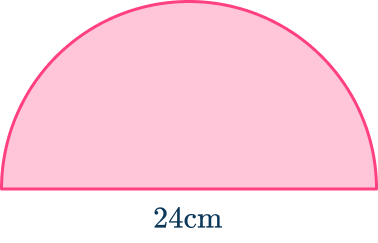
Determine the length of the radius \textbf{r}.
Diameter: D=24\mathrm{~cm}
Radius: r=24\div{2}=12\mathrm{~cm}
Find the size of the angle creating the sector \bf{\theta}.
Angle: \theta=180^{\circ} (the angle in a semicircle is 180^{\circ} )
Substitute known values into the formula for the area of a sector and solve.
Example 3: calculate the area of a sector (with an angle given)
Calculate the area of the sector shown below.
Give your answer to the nearest tenth.
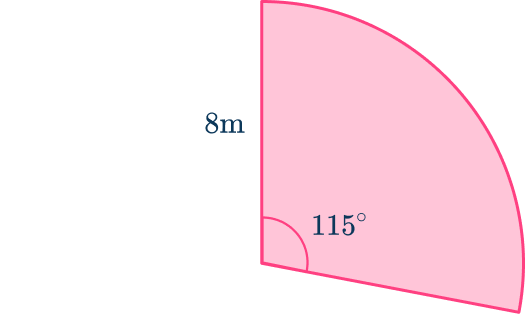
Determine the length of the radius \textbf{r}.
Radius: r=8\mathrm{~m}
Find the size of the angle creating the sector \bf{\theta}.
Substitute known values into the formula for the area of a sector and solve.
Example 4: calculate the area of a sector (the angle is not given – cosine rule)
AOB is a sector of a circle.
The length of the radius (OB) is 9\mathrm{~cm}.
The length of a chord (AB) is 10\mathrm{~cm}.
Calculate the area of the sector AOB below.
Give your answer to the nearest hundredth.
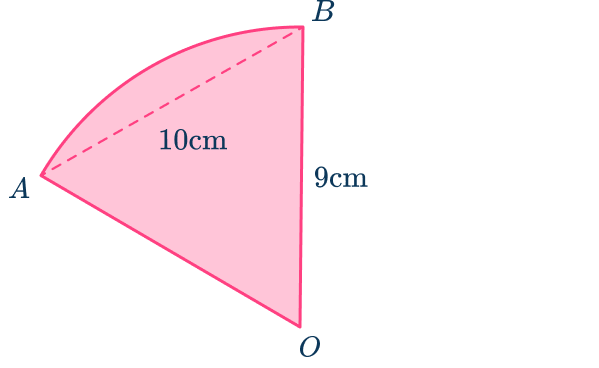
Determine the length of the radius \textbf{r}.
Radius: r=9\mathrm{~cm}
Find the size of the angle creating the sector \bf{\theta}.
In this example, you are not given the angle of the sector, you need to calculate it first.
Here, you can use the triangle created by the two radii and the chord to find the angle (see below).
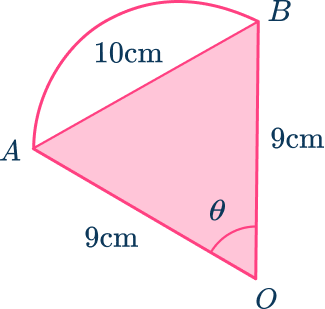
In this example, you need to apply the cosine rule to find the angle.
a^2=b^2+c^2-2bc\cos(A)
A is the angle you are trying to find, labeled \theta. You can therefore use the rearranged cosine rule to find the angle.
\cos(A)=\cfrac{b^{2}+c^{2}-a^{2}}{2bc}
As A=\theta, \, a=10\mathrm{~cm}, \, b=9\mathrm{~cm}, and c=9\mathrm{~cm}
The size of the angle creating the sector is 67.5^{\circ} .
Substitute known values into the formula for the area of a sector and solve.
How to solve problems involving an area of a sector
In order to determine missing angle or radius given the area of a sector:
- Clearly state which of the properties you know (radius/angle of sector, area of sector).
- Substitute known values into the formula for the area of a sector.
- Solve for the unknown value.
Example 5: finding the radius given the area of the sector
The sector below has an area of 120\mathrm{~cm^2}.
Calculate the length of x.
Give your answer to the nearest hundredth.
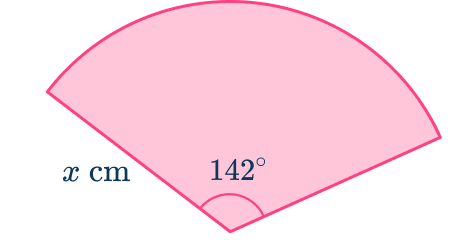
Clearly state which of the properties you know (radius/angle of sector, area of sector).
Radius: r=x\mathrm{~cm}
Angle of sector: \theta=142^{\circ}
Area of sector: A=120\mathrm{~cm}^2
Substitute known values into the formula for the area of a sector.
Solve for the unknown value.
Divide each side of the equation by the fraction.
\cfrac{21600}{71}=\pi\times{x^2}
Divide each side of the equation by \pi.
96.83793721…=x^{2}
Square root each side of the equation to find x.
x=9.840626871…
x=9.84\mathrm{~cm}\text{ (2dp)}
Example 6: finding the angle of a sector given the area of the sector
The sector below has an area of 62\mathrm{~cm}^2.
Calculate the length of x.
Give your answer to the nearest hundredth.

Clearly state which of the properties you know (radius/angle of sector, area of sector).
Radius: r=8.5\mathrm{~cm}
Angle of sector: \theta
Area of sector: 62\mathrm{~cm}^2
Substitute known values into the formula for the area of a sector.
Divide both slides by 72.25 .
\cfrac{248}{289}=\cfrac{\theta}{360}\times\pi
Divide both slides by \pi .
0.27315…=\cfrac{\theta}{360}
Multiply both slides by 360 .
\theta=98.33462505…
\theta=98.33^{\circ}\text{ (2dp)}
Teaching tips for area of a sector
- Provide worksheets with different circle and sector problems. Use activities that require cutting out sectors from paper circles.
- For advanced students, connect this topic to trigonometry, especially when dealing with radian measures.
- Ensure students understand the parts of a circle, including the center of the circle and the diameter and radius of a circle. Students should also know circle formulas for finding the area and circumference of the circle.
Easy mistakes to make
- Confusing the segment/sector
A segment is made from a chord while a sector will have lines (radii) coming from the origin.
Sectors are a portion of a circle; it can be helpful to think of a sector as a pizza slice.
- Finding the area of the whole circle not the area of the sector
Remember to find the fraction of the circle that makes the sector, not the area of the whole circle. To find the area of a sector, use \cfrac{\theta}{360}\times\pi{r^2} not \pi{r^2} .
- Incorrect use of the cosine rule
Many mistakes are made when applying other rules within a sector question, such as the cosine rule. Take your time with these parts and regularly ask if your answer makes sense within the context of the question. If you need to review the cosine rule, do so before continuing.
- Using incorrect units
The area of a sector, like any area, is measured in square units. The specific units depend on the units used for the radius of the circle. (For example, if the radius is measured in centimeters, the area would be measured in square centimeters.)
Related sectors, arcs and segments of a circle lessons
Practice area of a sector questions
1. Calculate the area of this sector in terms of \pi.





2. Calculate the area of this semicircle in terms of \pi.
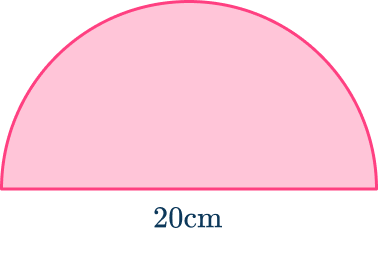




Since this is a semicircle, you know the angle measure is 180^{\circ}.
\begin{aligned}A&=\cfrac{\theta}{360}\times\pi{r^2} \\\\ &=\cfrac{180}{360}\times\pi\times{10^2} \\\\ &=50\pi\mathrm{~cm}^2 \end{aligned}
3. Calculate the area of the sector. Round your answer to the nearest tenth.





\begin{aligned}A&=\cfrac{\theta}{360}\times\pi{r^2} \\\\ &=\cfrac{270}{360}\times\pi\times{8^2} \\\\ &=48\pi \\\\ &=150.8\mathrm{~cm}^2\text{ (1dp)} \end{aligned}
4. Calculate the area of this sector. Write your answer to the nearest hundredth.
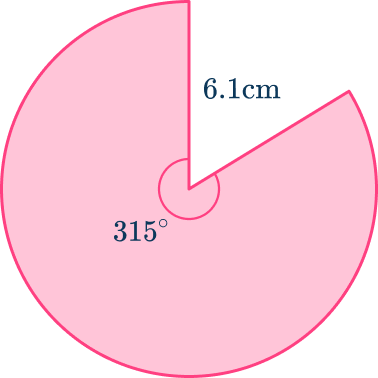




5. The area of the sector is 34.6\mathrm{~mm}^2 and the angle \theta=12^{\circ}.
Determine the radius of the sector to the nearest hundredth.





6. AOB is a sector of a circle where A and B are two ends of the arc of the sector, and O is the center. The chord AB=2.3\mathrm{~m} and the radius AB=16.5\mathrm{~m}. Calculate the area of the sector to 3 significant figures.




Use the cosine rule to determine the size of angle \theta.
a^{2}=b^{2}+c^{2}-2bc\cos(A) rearranges to become \theta=\cos^{-1}\left(\cfrac{b^{2}+c^{2}-a^{2}}{2bc}\right).
Here, a=2.3\mathrm{~m}, \, b=16.5\mathrm{~m}, \, c=16.5\mathrm{~m}
\begin{aligned}\theta&=\cos^{-1}\left(\cfrac{b^{2}+c^{2}-a^{2}}{2bc}\right) \\\\ &=\cos^{-1}\left(\cfrac{16.5^{2}+16.5^{2}-2.3^{2}}{2\times{16.5}\times{16.5}}\right) \\\\ &=7.993164702… \\\\ &=7.99^{\circ}\text{ (3sf)} \end{aligned}
Substitute the values of the radius 16.5\mathrm{~cm} and the angle 7.99^{\circ} into the formula for the area of a sector:
\begin{aligned}A&=\cfrac{\theta}{360}\times\pi{r^2} \\\\ &=\cfrac{7.99}{360}\times\pi\times{16.5^2} \\\\ &=\pi\times6.0424375 \\\\ &=18.98287726… \\\\ &=19.0\mathrm{~cm}^{2}\text{ (3sf)} \end{aligned}
Area of a sector FAQs
The area of a sector is the space inside the section of the circle created by two radii and an arc. It is a fraction of the area of the entire circle.
To find the area of a sector, you can use the area formula for a sector of a circle. Area of a sector formula =\cfrac{\theta}{360}\times\pi{r^2}
The area of a sector measures the space inside the sector, while the perimeter of a sector measures the distance around the sector, including the arc and the two radii.
The next lessons are
Still stuck?
At Third Space Learning, we specialize in helping teachers and school leaders to provide personalized math support for more of their students through high-quality, online one-on-one math tutoring delivered by subject experts.
Each week, our tutors support thousands of students who are at risk of not meeting their grade-level expectations, and help accelerate their progress and boost their confidence.

Find out how we can help your students achieve success with our math tutoring programs.
[FREE] Common Core Practice Tests (3rd to 8th Grade)
Prepare for math tests in your state with these 3rd Grade to 8th Grade practice assessments for Common Core and state equivalents.
Get your 6 multiple choice practice tests with detailed answers to support test prep, created by US math teachers for US math teachers!